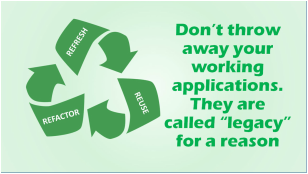In the past if you wanted to do anything the least bit interesting on the Web you needed to have a variety of skills, such as HTML and CSS coding. You needed to know about JavaScript, or VB Script, and JSP or ASP .NET. You also needed to invest in IDEs or editors for developing your site presentation, and you had to have computer systems on the Internet to host a Web Server, or a Service Provider who hosted Web sites. This often resulted in a large investment in time, education, equipment, and money.
Today, however, there are dozens of companies that specialize in providing website hosting, and many have “drag and drop” content builders that you can use online – no longer requiring the large investment in development tools and servers on your part.
The result is it is much easier, and less expensive, for the common individual or small company to get ‘on the web’ with a reasonably professional, and reasonably functional website.
If that is the case, then why should you hire a professional to help you create and maintain your website?
The simple answer is, as much as anything, you’re hiring the experience that comes from someone who has been there before.
With today’s technology it is very easy to create a website that is attractive, and interesting to see – once. But they may be very hard to use, and people – your potential clients – may not come back.
On the other hand, it can be equally easy to build a web presence that says everything you want to say, but is dull and boring, or is difficult to use because it doesn’t take into account the human factors that are different between a mobile phone and a full sized desktop computer. It may contain graphics or other content that does not display on all devices.
In either case you end up losing business because people can’t, or won’t use your website.
It takes experience to know the difference between these very different requirements, and find the combination that is best for you.
Today, however, there are dozens of companies that specialize in providing website hosting, and many have “drag and drop” content builders that you can use online – no longer requiring the large investment in development tools and servers on your part.
The result is it is much easier, and less expensive, for the common individual or small company to get ‘on the web’ with a reasonably professional, and reasonably functional website.
If that is the case, then why should you hire a professional to help you create and maintain your website?
The simple answer is, as much as anything, you’re hiring the experience that comes from someone who has been there before.
With today’s technology it is very easy to create a website that is attractive, and interesting to see – once. But they may be very hard to use, and people – your potential clients – may not come back.
On the other hand, it can be equally easy to build a web presence that says everything you want to say, but is dull and boring, or is difficult to use because it doesn’t take into account the human factors that are different between a mobile phone and a full sized desktop computer. It may contain graphics or other content that does not display on all devices.
In either case you end up losing business because people can’t, or won’t use your website.
It takes experience to know the difference between these very different requirements, and find the combination that is best for you.
You can find information and a price list on some of the services we can provide here.
And you can download a PDF document with more information here.


 RSS Feed
RSS Feed

